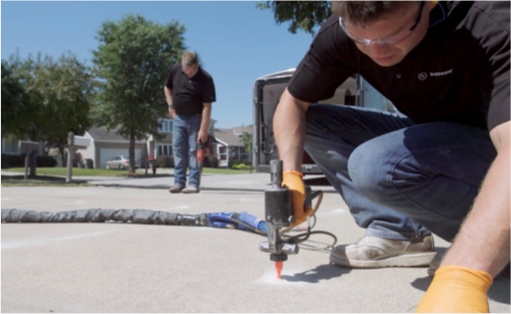Concrete plays a vital role in building strong foundations, driveways, patios, sidewalks, and various structural elements. However, over time, due to soil erosion, moisture fluctuations, and natural settling, concrete slabs can sink or become uneven. Uneven concrete not only looks unsightly but also creates safety hazards. Fortunately, concrete lifting offers a cost-effective and efficient solution to restore sunken or uneven concrete surfaces.
What is Concrete Lifting?
Concrete lifting, also known as slabjacking or mudjacking, is a repair technique used to raise and level sunken concrete slabs. Instead of replacing the entire slab, the lifting process involves injecting materials underneath the surface to push it back to its original position. This method is widely used for repairing sidewalks, driveways, garage floors, pool decks, and even foundation slabs.
How Does Concrete Lifting Work?
The process of concrete lifting typically involves the following steps:
- Assessment: A professional contractor inspects the affected area to determine the extent of damage and the best lifting approach.
- Drilling: Small holes (usually 1 to 2 inches in diameter) are drilled into the sunken slab.
- Injection: A lifting compound, such as a cement-based grout (mudjacking) or polyurethane foam (polyjacking), is injected through the holes to fill the voids beneath the slab.
- Lifting: As the material expands, it raises the slab to the desired level.
- Sealing: The holes are sealed, and the area is cleaned up, restoring the slab to a stable, level surface.
Benefits of Concrete Lifting
1. Cost-Effective
One of the biggest advantages of concrete lifting is the cost savings. It is typically 50% to 70% cheaper than tearing out and replacing concrete. Homeowners and businesses can save significant money without compromising quality.
2. Quick and Efficient
Concrete lifting projects are usually completed within a few hours, compared to days required for demolition and repouring new concrete. It minimizes downtime, especially for commercial properties.
3. Minimal Disruption
The process is non-invasive and generates minimal mess. Since there’s no need to remove and dispose of old concrete, the area remains relatively clean.
4. Environmentally Friendly
By reusing the existing concrete slab, this method reduces construction waste. Polyurethane foam, commonly used in modern lifting techniques, is also eco-friendly and long-lasting.
5. Durable Results
The lifting materials are designed to withstand extreme temperatures and moisture, providing long-term stability and reducing the risk of future settling.
Common Applications of Concrete Lifting
- Driveways: Prevent trip hazards and improve curb appeal.
- Sidewalks and Walkways: Ensure pedestrian safety and ADA compliance.
- Garage Floors: Fix uneven floors without moving heavy machinery.
- Patios and Pool Decks: Avoid cracking and create a level surface.
- Foundations: Help restore structural integrity in residential and commercial buildings.
Mudjacking vs. Polyjacking
There are two main types of concrete lifting techniques:
1. Mudjacking
- Uses a slurry mixture of water, soil, sand, and cement.
- Cost-effective for large areas.
- Heavier material, which may lead to further soil compression over time.
2. Polyjacking (Foam Lifting)
- Uses high-density polyurethane foam.
- Lightweight and expands quickly.
- More expensive but highly precise and long-lasting.
Choosing the right method depends on the type of project, budget, and soil conditions.
Signs You Need Concrete Lifting
- Visible sinking or uneven concrete surfaces.
- Cracks forming in slabs or foundation.
- Pooling water or drainage issues.
- Doors and windows not closing properly.
- Trip hazards on walkways or driveways.
When to Avoid Concrete Lifting
While concrete lifting is a great solution for many issues, it may not be suitable in the following cases:
- Slabs that are severely cracked or crumbled.
- If the underlying soil is unstable or subject to frequent movement.
- When structural reinforcement is needed (e.g., in foundation failure cases).
In such scenarios, replacement or additional structural repairs might be a better option.
FAQs: Concrete Lifting
Q1: How long does concrete lifting take?
Most residential concrete lifting jobs are completed in a few hours. The exact time depends on the size and complexity of the area being repaired.
Q2: Is concrete lifting a permanent fix?
Concrete lifting is a long-lasting solution. Polyurethane foam can last for decades, while mudjacking offers durability of 5 to 10 years, depending on soil conditions and use.
Q3: Can I walk or drive on the slab after lifting?
Yes! In most cases, you can walk on it within hours and drive on it within 24 hours, especially when polyurethane foam is used.
Q4: How much does concrete lifting cost?
The cost varies based on the method used and size of the project. On average:
- Mudjacking: $3 to $6 per square foot.
- Polyjacking: $5 to $12 per square foot.
Q5: Is concrete lifting safe for the environment?
Yes. Polyurethane foam is non-toxic, and mudjacking uses natural materials. Both methods minimize waste by preserving existing concrete.
Q6: Can concrete lifting fix cracks?
While lifting addresses the underlying cause of uneven slabs, surface cracks may still need to be filled or sealed afterward for aesthetic purposes.
Q7: Can I DIY concrete lifting?
It’s not recommended. The process requires specialized equipment and expertise to avoid damaging the slab or worsening the problem. Always hire a professional.
Conclusion
Concrete lifting is a smart, sustainable, and affordable way to repair uneven surfaces without the hassle of full slab replacement. Whether you’re a homeowner looking to fix your driveway or a business needing level sidewalks, this method offers a quick return to functionality with long-term results. Always consult a qualified contractor to assess your situation and recommend the best solution.

